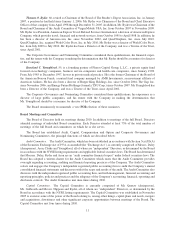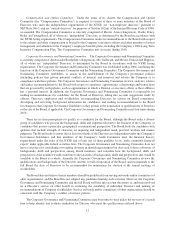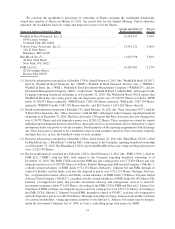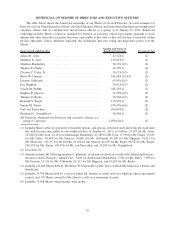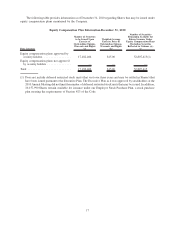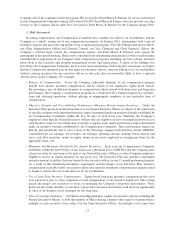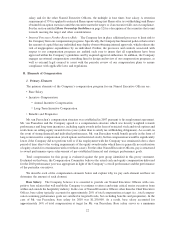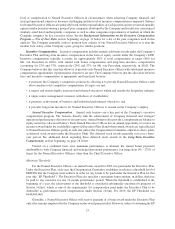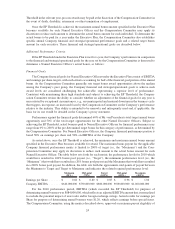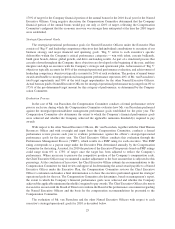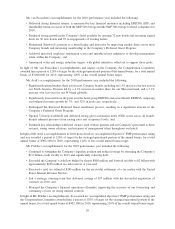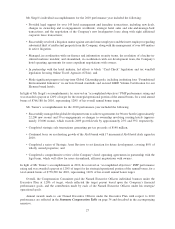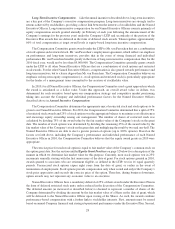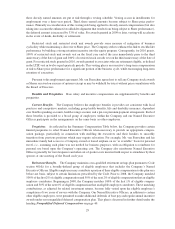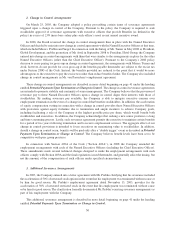Starwood 2010 Annual Report Download - page 33
Download and view the complete annual report
Please find page 33 of the 2010 Starwood annual report below. You can navigate through the pages in the report by either clicking on the pages listed below, or by using the keyword search tool below to find specific information within the annual report.Company and of the companies in the peer group. The fees paid to Pearl Meyer & Partners for services performed
for the Compensation Committee during 2010 were $136,000. Pearl Meyer & Partners does not provide any other
services to the Company and no other fees were paid to Pearl Meyer & Partners by the Company during 2010.
3. Risk Assessment
In setting compensation, our Compensation Committee also considers the risks to our stockholders, and the
Company as a whole, arising out of our compensation programs. In January 2011, management held a special
meeting to discuss and assess the risk profile of our compensation programs. The Chief Human Resources Officer,
our Chief Administrative Officer and General Counsel, our Vice Chairman and Chief Financial Officer, the
Company’s external legal counsel for compensation matters, and Pearl Meyer & Partners were among the
participants in the special meeting. Their review considered risk-determining characteristics of the overall structure
and individual components of our Company-wide compensation program, including our base salaries, incentive
plans (both at the executive and property management levels) and equity plans. A report of the findings was
provided to the Compensation Committee for its review and consideration. Following this assessment, we believe
that the Company has instituted policies that align our executive officers’ interests with those of our stockholders
without creating incentives for our executive officers to take risks that are reasonably likely to have a material
adverse effect on the Company. For example,
•Balance of Compensation: Across the Company, individual elements of our compensation program
include base salaries, incentive compensation, and for certain of our employees, equity-based awards.
By providing a mix of different elements of compensation which reward both short-term and long-term
performance, the Company’s compensation programs as a whole provide a balanced approach to incentiv-
izing and retaining employees, without placing an inappropriate emphasis on any particular form of
compensation.
•Objective Formula and Pre-established Performance Measures Dictate Annual Incentives: Under the
Executive Plan, payment of annual incentives to our Named Executive Officers is subject to the satisfaction
of specific company-wide annual performance targets determined under an incentive formula established by
our Compensation Committee within the first 90 days of each fiscal year. Similarly, the Company’s
employees other than the Named Executive Officers that are eligible to receive an annual incentive receive
such incentive subject to the satisfaction of specific company-wide annual performance targets determined
under an incentive formula established by our Compensation Committee. These performance targets are
directly and specifically tied to one or more of the following company-wide business criteria: EBITDA,
consolidated pre-tax earnings, net revenues, net earnings, operating income, earnings before interest and
taxes, cash flow measures, return on equity, return on net assets employed or earnings per share for the
applicable fiscal year.
•Minimum and Maximum Thresholds For Annual Incentives: Each year our Compensation Committee
establishes within the first 90 days of any fiscal year a threshold level of EBITDA that the Company must
achieve in order for any bonus to be paid to our Named Executive Officers or other Company employees
eligible to receive an annual incentive for any given year. The Executive Plan also specifies a maximum
incentive amount, in dollars, that may be paid to any executive officer for any 12-month performance period.
As a result of this threshold performance requirement and the design of our Executive Plan, incentive
compensation is payable under our incentive plans only upon the attainment of performance targets related
to business criteria that are in the interests of our stockholders.
•Use of Long-Term Incentive Compensation: Equity-based long-term incentive compensation that vests
over a period of years is a key component of total compensation of our executive employees. This vesting
period encourages our executives to focus on sustaining the Company’s long-term performance. These
grants are also made annually, so executives always have unvested awards that could decrease significantly
in value if our business is not managed for the long term.
•Share Ownership Guidelines: Our Share ownership guidelines require our executive officers, including the
Named Executive Officers, to hold that number of Shares having a market value equal to or greater than a
multiple of each executive’s base salary. For the Chief Executive Officer, the multiple is five times base
21


